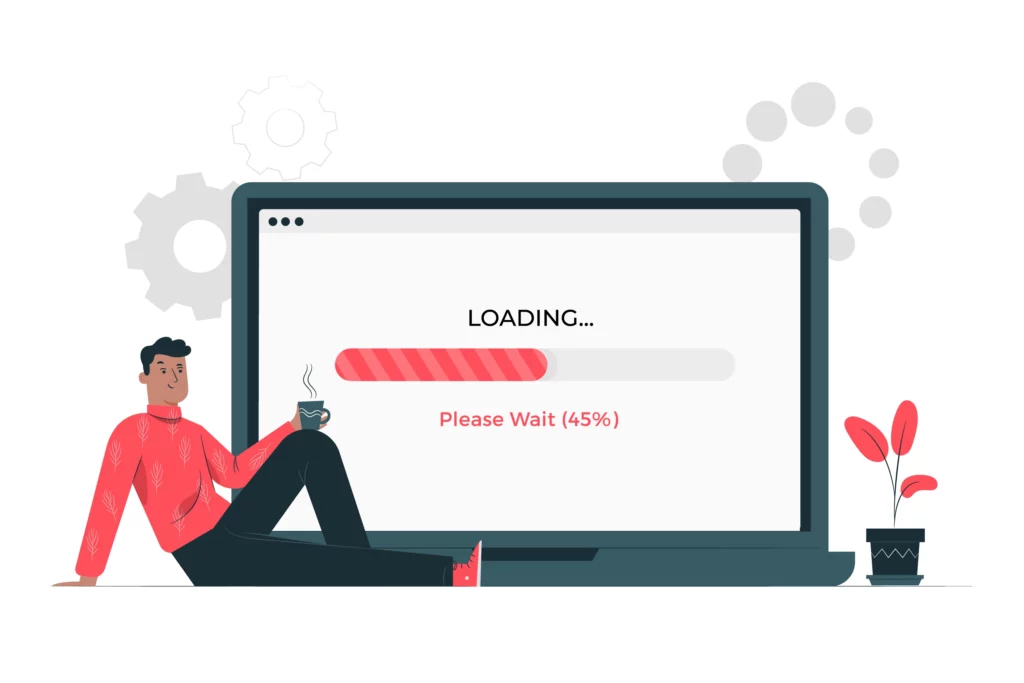Website design is a key factor in creating a strong online presence. In today's digital world, visual impact and user experience crucial for attracting visitors and achieving website goalsWhen designing a website, we aim to achieve a harmonious blend of aesthetic appeal, functionality and ease of use. In this chapter, we will explore why website design is important and how visual appeal and user experience affect the success of a website.
Visual impression
| Key elements for visual impact |
|---|
| Attractive design |
| Use of color and contrast |
| Consistency and unity |
| Appropriate typography |
| Visual hierarchy |
| Using attractive images |
| Clear organization of content |
Visual impression is extremely important in website design, as it attracts users' attention and creates an initial impression of the website. To achieve a strong visual impression, there are a few key elements to consider.
- Attractive design: A website should have an attractive and aesthetically pleasing design. This includes choosing an appropriate color palette, using contrast, placing elements correctly, and ensuring consistency throughout the design.
- Use of color and contrast: Colors play an important role in creating a visual impression. Choose colors that are consistent with your brand image and create the desired atmosphere. It is also important to use contrast between colors properly to highlight important elements and ensure readability.
- Consistency and Uniformity: A website should be consistent throughout its design. This includes using uniform typography, the same style of graphics, consistent element placement, and a uniform choice of design elements throughout the page.
- Appropriate typography: Choose a typography that is appropriate for your message and target audience. Ensure good readability of the text and follow a typography hierarchy to emphasize important elements.
- Visual hierarchy: Guide users through your website with proper visual hierarchy. Use different sizes, colors, and shapes to highlight main headings, subheadings, and key information.
- Use compelling images: Images are a powerful visual element that can instantly grab attention. Choose high-quality, compelling images that are consistent with the theme and message of your website. Use them thoughtfully, and adjust their size and layout to match the design.
- Clear content organization: A website should have clearly organized content that is easy to read and navigate. Use appropriate tags, sections, paragraphs, and lists to break up content into manageable units.
To achieve a strong visual impression, it is important to use these elements thoughtfully and in line with your brand and target audience. With a well-crafted visual impression, you will create an attractive and professional website that will impress users.
User experience
User experience is crucial in website design. Providing a positive user experience has many benefits, as it attracts and retains visitors and encourages greater interaction. Below are the key elements you should pay attention to when improving the user experience.
| User experience elements | Description |
|---|---|
| Simplicity and clarity of use | The website should be intuitive and easy to navigate. |
| Page loading speed | Users expect fast loading websites. |
| Device adaptability | The website must display correctly on different devices. |
| Accessibility | The website must be accessible to all users. |
| Quality content | The content must be relevant, clear and easy to understand. |
| Interactivity and feedback | The website should be enriched with interactive elements. |
- Simplicity and clarity of use: The website should be intuitive and easy to navigate. Users should have no trouble finding the information they are looking for and moving quickly between different sections.
- Page load speed: Users expect websites to load quickly. Long loading times can negatively impact the user experience and cause users to abandon the site. Optimize website loading speed for better user experience.
- Device Responsiveness: A website must display correctly on a variety of devices, including desktops, tablets, and smartphones. Users access websites on a variety of devices, so it's important to ensure that the page scales properly based on the screen and device size.
- Accessibility: The website should be accessible to all users, including people with disabilities. Ensure that the website is designed to allow the use of screen readers and support other accessibility features.
- Quality content: The content on your website should be relevant, clear, and easy to understand. Ensure that the text is high-quality and tailored to your target audience, and use appropriate graphics and visuals to complement the content.
- Interactivity and feedback: The website should be enriched with interactive elements that encourage users to interact. Include feedback options such as contact forms, comments or product ratings, which will encourage greater user engagement and involvement.
By improving these elements of the user experience, you will create a positive impression on visitors and increase the effectiveness of your website. Also, don't forget about online safetyUser experience is even more important in online stores, as it can be the deciding factor as to whether a user will become a customer or not, which is why it is occasionally online store renovation so important.
Key elements of website design
When designing websites, it is important to consider a number of key elements that affect the user experience and performance of the website. Below are some important elements to pay attention to:
Structure and organization of content
- Clear hierarchy: A website should have a clear hierarchy that makes it easy for users to find the information they want. The main menu, submenus, and categories should be logically structured and follow a meaningful sequence.
- Meaningful content layout: The content on your website should be organized in a way that makes it easy to read and understand. Important information should be placed in prominent places, while less important information should be within reach but not overpowering the main elements.
User interface
- User-friendly design: The design of the website should be intuitive and easy to use. Clear buttons, links, and icons should make it easy for users to interact with the website.
- Easy search: The search box should be clearly visible and easily accessible so that users can quickly find the information they want.
Using attractive images and media
- Quality Images: Using quality images and graphics on your website adds to its visual appeal. Images should be well-lit, sharp, and appropriately sized so they don't slow down page loading.
- Video content: Including video content on your website can attract more user attention. Make sure the videos are high quality, properly optimized, and play flawlessly.
Appropriate typography
- Text readability: Choose a typography that is easy to read and does not cause eye strain. The size and color of the text should be adjusted for optimal readability.
- Text hierarchy: Use different text styles, such as headings, subheadings, paragraphs, and highlighted text, to create a clear hierarchy of content.
When designing websites, it is also important to follow accessibility guidelines so that people with different abilities can use the website.
Taking these key elements into account will contribute to the successful design of websites that are attractive, user-friendly, and functional.
The importance of loading speed in website design

Website loading speed is crucial for a positive user experience and the success of a website. By loading quickly, we avoid user frustration and keep their attention. Below are the reasons why loading speed is important:
User experience
Fast loading of web pages positively affects the user experience. Users want to access information immediately, without waiting for long loading times. If a page responds too slowly, users may quickly decide to leave the site.
SEO ranking
Loading speed also affects website ranking in search enginesWebsites that load quickly have a better chance of ranking higher in search results. Search engines like Google place a lot of emphasis on loading speed as one of the factors in determining rankings.
Visitor retention
Slow page loading often leads to a high bounce rate, meaning users quickly leave your site without interacting. Loading speed affects whether visitors will stay on your site and explore its content.
Mobile devices
Websites must also be optimized for mobile devices, where loading speed is especially important. Mobile connections are not always as fast as fixed internet connections, so it is even more crucial that pages load quickly on mobile devices.
When designing websites, there are a number of strategies to consider to optimize loading speed, such as image compression, minification and merging of CSS and JavaScript files, use of caching, and server optimization.
Caring for loading speed is very important for providing an excellent user experience and achieving higher rankings and greater visitor retention on the website. Loading speed is also the most common reason for online store renovation.
Adapting design for different devices

Today, we have a wide range of devices available to access the web, including desktop computers, tablets, and smartphones. That's why it's crucial that your website design adapts to different devices. If it doesn't, it's time to website redesignBelow are some key guidelines when adapting design for different devices:
Desktop computers
When designing for desktop, we have more space to display content. This allows us to use larger images, more complex layouts, and more detail on the screen. It is crucial to ensure that content is displayed at an optimal size and that navigation is easy to use with a mouse.
Tablets
Tablets are a popular choice for web browsing among users. When designing for tablets, the limited screen space must be taken into account, so it is important to adapt content to be clear and easy to read. Using responsive design that adapts to the screen size is key to ensuring good user experience on tablets.
Smartphones
Smartphones have become the most popular device for accessing the web. Due to the smaller screen size, design needs to be adapted so that content is clear, readable and easy to use on touch. Using mobile-friendly elements such as large buttons and easy navigation is key to a good user experience on smartphones.
When adapting your design for different devices, you should also consider other factors, such as loading speed, image and media customization, and the use of responsive layouts. It is important that your website displays optimally on all devices so that users get a consistent and enjoyable experience, no matter which device they are using.
Tips for improving visual impression and user experience
Visual impression and user experience are key factors in the success of websites. Below are some tips that will help you improve the visual impression and user experience of your website:
- Use quality visuals: Images and graphics play an important role in the visual appeal of a website. Make sure you use quality images that are clear, sharp, and attractive. Also, keep the size of your images in mind so that your website loads quickly. Using visuals like icons, illustrations, and videos can grab your visitors’ attention and enhance the visual appeal.
- User Experience Testing and Optimization: Regularly test the user experience of your website and make improvements based on user feedback. Check if navigation is easy, key information is clearly displayed, and all interactive elements are functional. Also optimize forms for easy completion and reduce the number of steps to achieve the goalThis will ensure a pleasant user experience and greater user satisfaction.
- Use responsive design elements: Responsive design is key to making your website adaptable to different devices and screens. Make sure your website is responsive, meaning it adapts to screen sizes and provides an optimal user experience on desktops, tablets, and smartphones. Use flexible layouts, adaptive images and media, and responsive fonts that will automatically adjust to the screen size.
The future of web design
Web design is constantly evolving and adapting to new trends and technologies. Here are some of the advancements we can expect in the future:
- New trends and technologies: Web design is likely to evolve towards more interactive and dynamic experiences. The use of advanced animations, microinteractions, and virtual reality will become increasingly widespread. We can also expect greater use of artificial intelligence and machine learning to personalize web content and automate certain processes.
- Advances in artificial intelligence: Artificial intelligence will play a significant role in improving the user experience. Advanced machine learning techniques will enable personalization of content and recommendations based on individual users. We can also expect increased use of virtual assistants and chatbots to communicate with users.
When designing websites, it is crucial to keep up with trends and technological innovations to ensure a modern and engaging user experience. At the same time, it is important to maintain a focus on the user and ensure that the website is intuitive, easy to use, and informative.
Conclusion
When designing websites, it is crucial to create a visual impression and improve the user experience. Websites should have an attractive design, simple navigation, and be quick and easy to use. First impressions are crucial, so make sure they are visually appealing and convey clear messages. Regularly monitor analytics, follow trends, and Renovate your websiteto achieve long-term success. Website design is a constant process of learning and adaptation that requires attention to detail.

